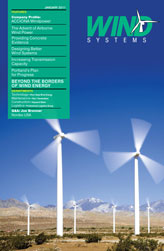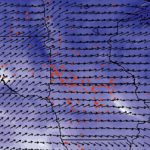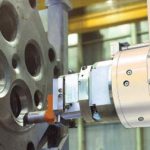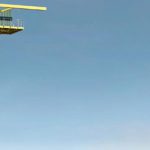Engineers at the U.S. Department of Energy’s National Renewable Energy Laboratory use LMS Test.Lab in performing modal testing on next-generation wind power systems destined to radically change America’s energy policies in decades to come. As an inexhaustible, clean and economical way to generate electricity, wind power often tops the list of alterative energy sources for companies around the world facing volatility in fossil fuel prices, supply uncertainties and environmental issues. The “20% Wind Energy by 2030” study published by the U.S. Department of Energy (DOE) in 2008 stated that generating 20% of the country’s electricity from wind power is feasible by the year 2030.
To reach this ambitious goal, efforts are being stepped up to boost U.S. wind capacity to 300 gigawatts (GW), a more than tenfold increase from present levels. In 2008 alone, the United States added more than 8 GW of new installations, bringing the nation’s total wind energy capacity to more than 25 GW—the largest in the world according to the American Wind Energy Association. Figure 1
Generating this much power will take more than building bigger wind turbines, however. According to DOE, the reliability and operability of turbines must improve. Also, with the number of easily accessible high-wind-speed sites dwindling, turbines that operate efficiently in low-speed sites must be developed. All this will require advances in designing, simulating, and testing these next-generation machines, including variable-speed drive trains and advanced controls for adjusting blade pitch to match wind conditions. Figure 2
Tools for Advanced Testing
Work in addressing these requirements is spearheaded by the National Renewable Energy Laboratory (NREL), DOE’s primary research and development center for wind power. A key element of efforts at NREL’s National Wind Technology Center (NWTC) in Golden, Colorado, is aimed at testing proposed new concepts, as well as improving existing designs, often in connection with industry partners, including wind turbine manufacturers and component suppliers.
In particular, modal testing is performed to identify resonant frequencies of the wind machine. As a nationally certified test facility, the NWTC also performs modal analysis as part of a suite of dynamic vibration tests for certifying wind turbine designs. NREL recently installed an LMS Test.Lab data acquisition and analysis system for performing these modal and vibration tests, and LMS Virtual.Lab software for correlating and updating simulation models. Measurements are made using a 96-channel LMS SCADAS Mobile system consisting of three lightweight, battery-powered, laptop-size units that are easy to carry up into a wind turbine nacelle and between the NWTC and outdoor wind turbine sites. The portable units are less than a third the size and weight of the NWTC’s former cumbersome UNIX-based system. Figure 3
Full Modal Survey
NWTC engineers have already used the LMS system in performing a full system model survey of a specially modified three-bladed 600-kW wind turbine system known as the CART-3, which is used for advanced controls research. With its rotor fixed in a parked position accelerometers were placed on the entire structure, including points on the tower, rotor blades, gearbox, and nacelle. Blades were excited to vibrate with impact from an instrumented hammer. For other parts of the structure, hydraulic shakers were controlled by signals from the LMS SCADAS system, which measured amplitude response of the structure for various input frequencies.
According to NWTC Test Engineer Richard Osgood, one of the major advantages of using the LMS SCADAS Mobile was that it could be used as a distributed data acquisition system, with slave units on the rotor, blades, nacelle, tower, and even a remote meteorological tower to measure wind speeds—all daisy-chained together and connected by fiber-optic cables to a master unit on a truck on the ground at the base of the tower.
“This level of cost and efficiency is important in operations such as ours in which budgets are extremely tight,” he says. “Also, signal loss and background electronic interference was significantly reduced with a distributed system based on fiber optics, so less time is required in correcting for these discrepancies, especially in testing variable-speed drive trains that tend to generate considerable radio-frequency noise.”
Using multiple-input/multiple-output acquisition and analysis capabilities for measured signals, the LMS system created plots—including animated mode-shape displays and frequency response functions (FRFs)—identifying 10 fundamental system modes of vibration of the structure including rotor bending and twisting, blade torsion, and tower fore-aft and side-to-side bending. The LMS system also accurately identified vibration modes often difficult to predict solely through simulation, such as coupled motion between the nacelle, tower, and rotor bending.
Test engineers used LMS Virtual.Lab software to correlate field test measurements with predicted results from a dynamic simulation model developed by NREL wind researchers. Initial evaluations were performed using a Modal Assurance Criteria (MAC) matrix diagram, showing where the experimental and theoretical types of modal data aligned and where they diverged. From this comparison the test engineers were able to provide the dynamist with information confirming simulation predictions and updating simulation modes when discrepancies were found. In addition, experimental identification of the turbine’s drive train frequencies was used to adjust the wind turbine controller and resolve vibration problems occurring during operation of the variable speed power electronics.
Adjusting Simulation Models
“For obtaining accurate predictions of turbine vibration characteristics, test-based modal analysis is critical to adjusting models for a wide range of simulation including finite element analysis, multi-body dynamics, aerodynamics, acoustics, and blade pitch control,” Osgood says.
“Stiffness attributes and damping characteristics computed by LMS Test.Lab from modal data is an essential structural parameter needed as inputs to the simulation model to accurately represent structural members as flexible, rather than entirely rigid bodies,” he says. “In this manner, simulations can more accurately predict the realistic bending and twisting motion of components that sometimes can lead to unacceptable deformations and instabilities.” Figure 4
An Integrated System
Osgood notes that having this wide range of capabilities in a single system was an important criterion in their selection process, with LMS Test.Lab providing a fully integrated suite of tools—test setup, control, measurement, signal conditioning, result analysis, data management, and report generation—all in the portable test unit. The LMS PolyMAX feature, for example, automatically highlights resonances so engineers can visually identify natural frequencies in minutes instead of spending hours looking through raw data. With an “Active Pictures” capability, live test data in the form of interactive, animated plots can be cut-and-pasted into Microsoft Office tools like Word and PowerPoint.
Integration of these functions, plus a fast processing speed, enables NWTC engineers to see results immediately after measurements are taken instead of waiting hours or days for post-processing. This fast visualization helps engineers verify the test on the spot, see right away how the structure behaves, get a good insight into the root cause of vibration problems, and easily identify particular areas that need further investigation. Figure 5
“A fully integrated system ensures that all tools we need are compatible and work together properly,” according to Osgood. “If a problem arises there is only one vendor to contact, and LMS has been extremely helpful in getting our engineers up and running on the new system.”
LMS Technology’s Role
“We are certainly honored for LMS technology to have a pivotal role in NREL’s testing operations for advanced wind energy systems,” says LMS Test Division Vice President Bruno Massa. “The selection of LMS for this critical work confirms the trust organizations have in LMS test solutions and demonstrates the effectiveness of the technology in supporting mission-critical applications in a wide range of industries around the world.” Figure 6








































